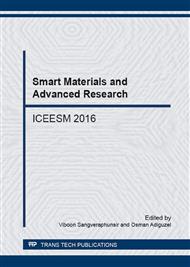p.3
p.7
p.12
p.17
p.22
p.27
p.32
p.37
Janssen’s Effect in Mechanical Behavior and Fracture of Granular Materials
Abstract:
In 1985, H.A. Janssen studied the structure of the forces inside a silo filled with granular materials, so-called Janssen’s Effect Method (J.E.M). This method is a unique property of confined granular materials. The pressure at the bottom saturated with an increasing filling height due to internal friction with side walls. In this research, we focus on the study of granular cohesionless materials such as sands and gravels, these forces are explained by adsorption and capillary phenomenon. Our main result shows that positive water pressures generate a mechanical effect with tendencies of removing the components of the porous medium corresponding to the mechanical buoyancy force (FB) that increases with increasing θ from calculated by Janssen's effect method. The topic in this research is once importance in study physical processes of the problem in the Geology Physics (i.e. the factor causing landslide).
Info:
Periodical:
Pages:
7-11
Citation:
Online since:
January 2017
Authors:
Price:
Сopyright:
© 2017 Trans Tech Publications Ltd. All Rights Reserved
Share:
Citation:


